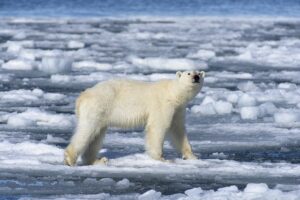What Are Polar Deserts?
Imagine a place so cold and dry that it feels like another planet, where ice stretches endlessly but rain is a rare visitor. That’s a polar desert—a unique biome defined by extreme cold and minimal precipitation, typically less than 250 mm annually. Unlike sandy deserts, these icy landscapes dominate Earth’s polar regions, covering vast areas of Antarctica and the Arctic. They’re not just frozen wastelands; they’re fascinating ecosystems with surprising life and geological wonders.
The Antarctic Polar Desert: The Coldest Desert on Earth
Defining Antarctica’s Polar Desert
Antarctica, the fifth-largest continent, spans 14.2 million square kilometers and is Earth’s largest desert due to its scant precipitation—averaging just 10 mm per year at the South Pole. Despite its icy blanket, 98% of the continent is a polar desert, with the interior receiving less moisture than the Sahara. The McMurdo Dry Valleys, a rare ice-free region, haven’t seen rain or snow in 14 million years, resembling Mars more than Earth.
Climate and Conditions
Antarctica’s climate is brutal, with winter temperatures plunging to -60°C (-76°F) and summer averages hovering around -20°C (-4°F). The lowest recorded temperature, -89.2°C (-128.6°F), was at Vostok Station in 1983. High winds carve the ice into surreal shapes, and the lack of water vapor limits cloud formation, making the interior eerily clear. This dryness, combined with high elevation (averaging 2,300 meters), amplifies the desert-like conditions.
Unique Features: The McMurdo Dry Valleys
The McMurdo Dry Valleys, a 4,800 km² ice-free oasis, are Antarctica’s strangest anomaly. Katabatic winds—powerful gusts racing down from glaciers—keep these valleys dry by evaporating moisture. Here, you’ll find hypersaline lakes like Don Juan Pond, so salty they never freeze, and soils hosting extremophile microbes. Walking here feels like stepping onto an alien planet, with barren gravel plains stretching under a stark, blue sky.
Wildlife and Adaptation
You’d think nothing could survive Antarctica’s harshness, but life finds a way. Penguins, like the emperor and Adélie, waddle through icy slopes, relying on the Southern Ocean for krill and fish. Seals, including leopard and Weddell, thrive in coastal waters. Microbes, such as cyanobacteria, live in ice sediments, fixing carbon dioxide from meltwater. These extremophiles, discovered in the 1970s, prove life’s resilience in the harshest conditions.
The Arctic Polar Desert: A Frozen Mosaic
Defining the Arctic Polar Desert
The Arctic polar desert, spanning 13.7 million square kilometers, stretches across northern Canada, Alaska, Greenland, Iceland, Norway, Sweden, Finland, and Russia. Unlike Antarctica’s continuous landmass, it’s a fragmented region of land, ocean, and permafrost. With annual precipitation below 50 cm, mostly as snow, and summer temperatures rarely exceeding 10°C (50°F), it’s a true polar desert, though less extreme than its southern counterpart.
Climate and Conditions
Arctic winters are dark and brutal, with temperatures dropping to -40°C (-40°F), and the lowest recorded at -68°C (-90°F). Summers bring 24-hour daylight, the midnight sun, but warmth is fleeting. High winds stir snow, creating an illusion of constant snowfall, while permafrost—a frozen layer of soil, gravel, and sand—dominates the landscape. Coastal areas, warmed by the Arctic Ocean, are milder than the inland tundra.
Unique Features: Permafrost and Tundra
Permafrost covers roughly 14 million square kilometers in the Arctic, locking the ground in a permanent freeze. In summer, a thin layer thaws, allowing sparse vegetation like mosses, lichens, and small shrubs to grow. The Arctic’s tundra regions, like those in Svalbard, bloom briefly in summer, offering a stark contrast to Antarctica’s barren interior. Icebergs and snow dunes add drama to the landscape, especially in Greenland.
Wildlife and Adaptation
The Arctic teems with life adapted to its extremes. Polar bears roam sea ice, hunting seals, while Arctic foxes and reindeer navigate the tundra. Walruses and whales, like orcas and humpbacks, thrive in icy waters. Birds such as Arctic terns and snow buntings migrate to breed in summer. These species have evolved thick fur, blubber, or rapid growth cycles to survive the short growing season and long polar night.
Comparing Arctic and Antarctic Polar Deserts
Key Differences
While both polar deserts share low precipitation and extreme cold, their differences are striking. Antarctica is a landmass surrounded by ocean, making it colder and drier, with minimal cloud cover inland. The Arctic, mostly ocean surrounded by land, is warmer due to ocean heat transfer. Antarctica’s ice sheet is permanent, while Arctic sea ice fluctuates seasonally. The Arctic supports more plant life, with 350 vascular plant species compared to Antarctica’s two.
Similarities
Both regions are classified as deserts due to low precipitation—less than 250 mm annually—and share the Köppen “EF” ice cap climate. They experience polar night (months of darkness) and midnight sun (continuous daylight). Both host extremophiles and are critical for studying climate change, as warming affects them disproportionately. Their stark beauty and unique ecosystems draw adventurers and scientists alike.
Comparison Table
| Feature | Antarctic Polar Desert | Arctic Polar Desert |
|---|---|---|
| Size | 14.2 million km² | 13.7 million km² |
| Precipitation | <50 mm/year, mostly snow | <50 cm/year, mostly snow |
| Temperature | -60°C (winter) to -20°C (summer) | -40°C (winter) to 10°C (summer) |
| Vegetation | Mosses, lichens, 2 flowering plants | Mosses, lichens, 350 vascular plants |
| Wildlife | Penguins, seals, whales | Polar bears, Arctic foxes, reindeer |
| Unique Feature | McMurdo Dry Valleys | Permafrost and tundra |
| Human Presence | Research stations only | Indigenous communities, research bases |
Why Polar Deserts Matter
Scientific Significance
Polar deserts are living laboratories for science. In Antarctica, the dry valleys are testing grounds for Mars exploration, as their conditions mimic the Red Planet’s surface. NASA’s Viking missions used these valleys to test instruments, and meteorites found here offer clues about the solar system’s origins. In the Arctic, permafrost studies reveal how thawing releases methane, accelerating climate change.
Climate Change Impacts
Polar deserts are climate change’s early warning systems. The Arctic is warming twice as fast as the global average, with models predicting ice-free summers by 2035. Antarctica’s ice sheets, holding 70% of Earth’s freshwater, could raise sea levels by 60 meters if melted. Monitoring these regions helps predict global impacts, from rising oceans to shifting weather patterns.
Ecological Importance
Despite their harshness, polar deserts support rich marine ecosystems. Antarctic krill sustain penguins, seals, and whales, while Arctic waters host plankton and fish that feed larger predators. These ecosystems are fragile; disruptions like warming or pollution could ripple through global food chains. Protecting polar deserts preserves biodiversity and maintains Earth’s climate balance.
Exploring Polar Deserts: How to Experience Them
Antarctic Expeditions
Want to see Antarctica’s polar desert up close? Expedition cruises, like those offered by Aurora Expeditions or Quark Expeditions, take you to the Antarctic Peninsula or McMurdo Dry Valleys. These trips, often 11–20 days, include zodiac landings, wildlife watching, and guided hikes. Prices start at $5,000–$15,000, depending on the season and itinerary. Book through trusted operators with permits to ensure eco-friendly travel.
Arctic Adventures
The Arctic offers diverse exploration options, from cruises around Svalbard to hiking in Greenland. Operators like Poseidon Expeditions provide trips with activities like kayaking, flightseeing, or Northern Lights viewing. Summer (June–August) is ideal for 24-hour daylight, while winter offers polar night experiences. Costs range from $3,000–$10,000. Always choose operators prioritizing sustainability.
Pros and Cons of Visiting Polar Deserts
Pros:
- Unique landscapes unlike anywhere else on Earth
- Rare wildlife encounters (e.g., penguins, polar bears)
- Opportunities for photography and adventure
- Contribute to scientific research through eco-tourism
Cons:
- High costs and logistical challenges
- Extreme weather requires specialized gear
- Limited travel seasons and accessibility
- Environmental impact concerns
Best Tools for Planning Your Trip
- Cruise Operators: Aurora Expeditions, Quark Expeditions, Poseidon Expeditions for curated polar tours.
- Booking Platforms: Adventure Life, Polar Cruises for comparing itineraries and prices.
- Gear Suppliers: REI, Patagonia for high-quality cold-weather clothing (wool layers, waterproof jackets).
- Weather Apps: Windy, AccuWeather for real-time polar weather updates.
- Travel Insurance: World Nomads for coverage in extreme environments.
A Personal Touch: My Imaginary Journey to a Polar Desert
Last winter, I daydreamed about standing in the McMurdo Dry Valleys, bundled in layers, staring at a landscape so alien it felt like science fiction. The silence was profound—no birds, no wind, just the crunch of my boots on gravel. I imagined spotting a Weddell seal in the distance, its sleek body a reminder that life persists against all odds. In the Arctic, I pictured kayaking near Svalbard, a polar bear eyeing me from an ice floe, its white fur blending with the snow. These mental journeys sparked my obsession with polar deserts—they’re not just places; they’re stories of survival and beauty.
People Also Ask (PAA)
What is a polar desert?
A polar desert is a cold, arid region with less than 250 mm of annual precipitation and summer temperatures below 10°C. Found in Antarctica and the Arctic, these deserts are often ice-covered but lack liquid water, supporting sparse life like extremophiles and hardy animals.
Why is Antarctica considered a desert?
Antarctica is a desert because it receives minimal precipitation—less than 50 mm annually in its interior. Despite its ice cover, the lack of rain or snowmelt creates desert conditions, especially in areas like the McMurdo Dry Valleys.
What animals live in polar deserts?
In Antarctica, penguins, seals, and whales thrive, along with microbes in ice. The Arctic hosts polar bears, Arctic foxes, reindeer, walruses, and birds like Arctic terns. These species are adapted to extreme cold and limited food sources.
Can you visit polar deserts?
Yes, polar deserts are accessible via expedition cruises, guided hikes, or research trips. Antarctica cruises visit the peninsula, while Arctic tours explore Svalbard or Greenland. Always choose eco-conscious operators to minimize environmental impact.
FAQ Section
How cold do polar deserts get?
Winter temperatures in Antarctica can drop to -60°C (-76°F), with a record low of -89.2°C. The Arctic sees -40°C (-40°F) on average, with extremes at -68°C. Both regions experience milder summers, but frostbite is a constant risk.
Are there plants in polar deserts?
Yes, but they’re sparse. Antarctica has mosses, lichens, and two flowering plants. The Arctic supports 350 vascular plant species, including shrubs and grasses, thriving in the brief summer thaw of permafrost.
How does climate change affect polar deserts?
Warming is melting Arctic sea ice, potentially ice-free by 2035, and thawing permafrost, releasing methane. In Antarctica, melting ice sheets threaten sea level rise. Both regions are critical for studying global climate impacts.
What’s the best time to visit polar deserts?
Antarctica’s summer (November–March) offers milder weather and 24-hour daylight. The Arctic’s summer (June–August) is ideal for wildlife and midnight sun. Winter visits (December–February) are best for Northern Lights in the Arctic.
Are polar deserts safe for tourists?
With proper preparation—layered clothing, experienced guides, and reputable operators—polar deserts are safe. Risks include extreme weather and wildlife encounters, so always follow safety protocols and choose eco-friendly tours.
Tips for Engaging with Polar Deserts
- Research Thoroughly: Read about polar ecosystems on sites like NASA Space Place or National Geographic for deeper insights.
- Join Guided Tours: Opt for operators like Aurora Expeditions for expert-led trips.
- Support Conservation: Donate to organizations like the Antarctic and Southern Ocean Coalition to protect these fragile ecosystems.
- Capture the Moment: Bring a high-quality camera for icebergs, wildlife, and surreal landscapes—perfect for Instagram-worthy shots.
Conclusion: The Allure of Polar Deserts
Polar deserts are more than frozen wastelands; they’re Earth’s last frontiers, where ice tells stories of resilience and beauty. From Antarctica’s McMurdo Dry Valleys to the Arctic’s blooming tundra, these regions captivate with their stark landscapes and tenacious wildlife. Whether you’re a scientist, adventurer, or dreamer, polar deserts offer a glimpse into nature’s extremes. Plan your visit, support conservation, and let these icy realms inspire you. Ready to explore? Check out Polar Cruises for your next adventure.







